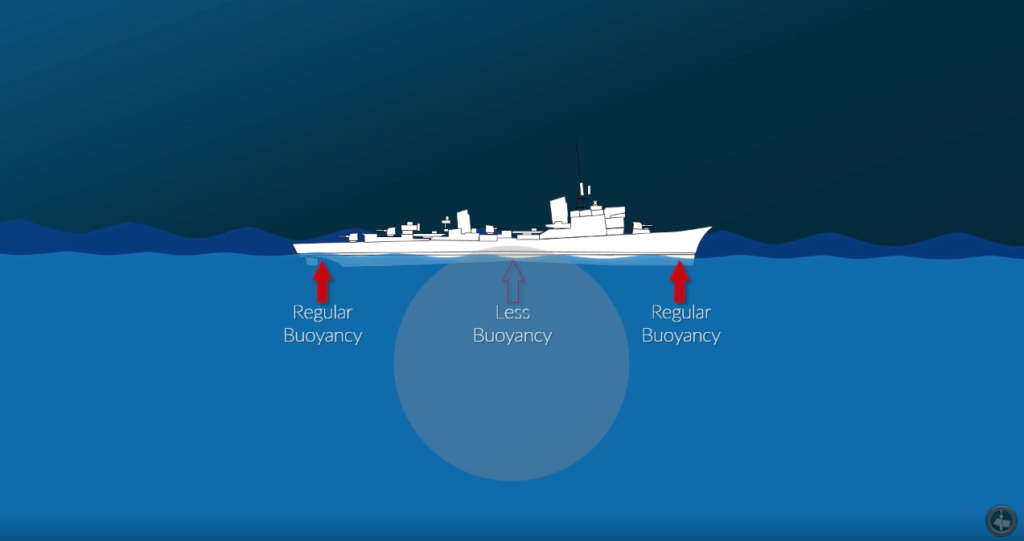Published on 09/26/2021 – Last Updated on 09/26/2021 by OTC
Since a dense medium surrounds the water, an underwater explosion has a different character than a regular explosion. When an underwater explosion occurs, a cavity of high-pressure gas is created, pushing the water outwards. This bubble is formed, but gas is produced as a result of the blast. Furthermore, the size of the bubble increases, but water is vaporized as a result of the heat. The blast’s energy now expands the bubble past the point of balance between the bubble and the odds of water pressure.
Water’s inertia causes the bubble to surpass the point at which its internal pressure equals the water’s external pressure. The bubble is then rarefied, which means it becomes less dense, and its radial motion is stopped. However, no equilibrium is reached, and the bubble contracts more than the remaining energy. As a result, it expands again, and the process is repeated, though it should be noted that nearly 90% of the energy is dissipated after the first expansion and contraction. Because of this, expansion, contraction, underwater explosions appear to be followed by other explosions.
Distinctions between an underwater explosion and a blast in the air
The effects of an underwater explosion can be divided into two distinct phenomena: the shock wave and bubble pulsation. So, what are the distinctions between an underwater explosion and a blast in the air? First, while overpressure rises rapidly at the shock front in air and water, it falls quickly in an air explosion. As a result, peak values in water are much higher than peak values at the same distance from an equal explosion in the air. Second, in the next stand, the sound velocity in water is nearly five times that of air. As a result, it creates rapid waves in the water.
An explosion of bottom mines in shallow water regions is one of the most dangerous short-distance (2-20 m) explosions. The pressure wave emitted by the button significantly amplifies ship destruction. Furthermore, the pulsation of the bubble itself generates additional shock waves. Underwater warheads use the interaction of the steam void created by the explosion with the target’s hull to be the most effective.
There are two types of bodies: surface bodies and submerged bodies. Underwater explosions are more damaging if they occur beneath the ship, and there’s a good reason for this if a warhead detonates beneath the boat. The bubble either lifts the keel to a certain extent or displaces water from that area. This area provides less buoyancy because of the lack of water, but the bow and stern are still supported. Aside from the shock wave, the stress in the midsection is caused by the ship falling into a hole in the water while the bow and stern are still supported by water.
In other words, the ship’s back is broken as it collapses under its weight. The massive destruction is caused by explosions beneath the keel amidships. Blasts near the bow or stern do not usually cause the vessel to sink. Also, keep in mind that the bubble will expand and contract several times. As a result, even if the ship survives the first oscillation, it may be destroyed during the subsequent fluctuations. However, this phenomenon only occurs near the surface. The increased pressure and buoyancy of the surrounding water limits the effect of a beneath to kill explosion as you go deeper underwater.

Bubble action more dangerous for submarines
Another effect is appropriate for submerged vessels. Under certain conditions, the migration of the bubble due to hydrodynamic and gravitational impact can result in a highly concentrated transfer of this momentum to ships or other structures, such that the bubble action can outweigh the shock wave’s damaging effect. The expanding and contracting steam bubble that will cause cyclic stress on the hull could damage submarines, which will be pretty unpleasant a few hundred meters below the surface.
Conclusion
An underwater explosion generates a positing bubble, which can cause continuous stress on a target and may cause long-term damage even if the initial shock wave is avoided. As a result, targets are ideally attacked with beneath-the-keel explosions, which allow the target’s weight to be used against it by creating a void beneath it. The targets are crushed under their weight. Although this method does not work for submerged targets, an exploding bubble adheres to the hull when it comes into contact, and the cyclic stress from the expanding and contracting bubble can damage the hull.
Check out Naval Library App to find out the specifications of the underwater weapons of different countries.
















Comments